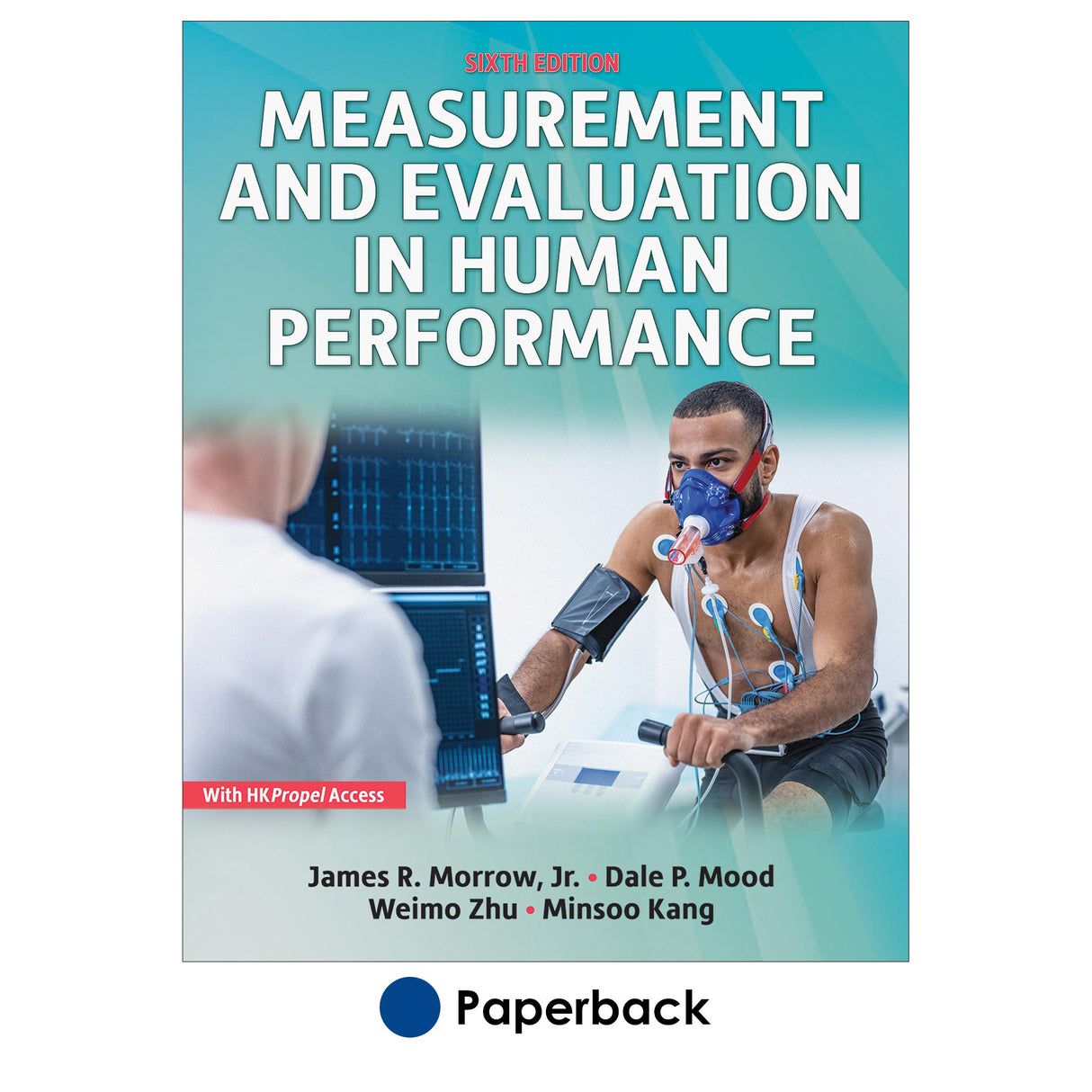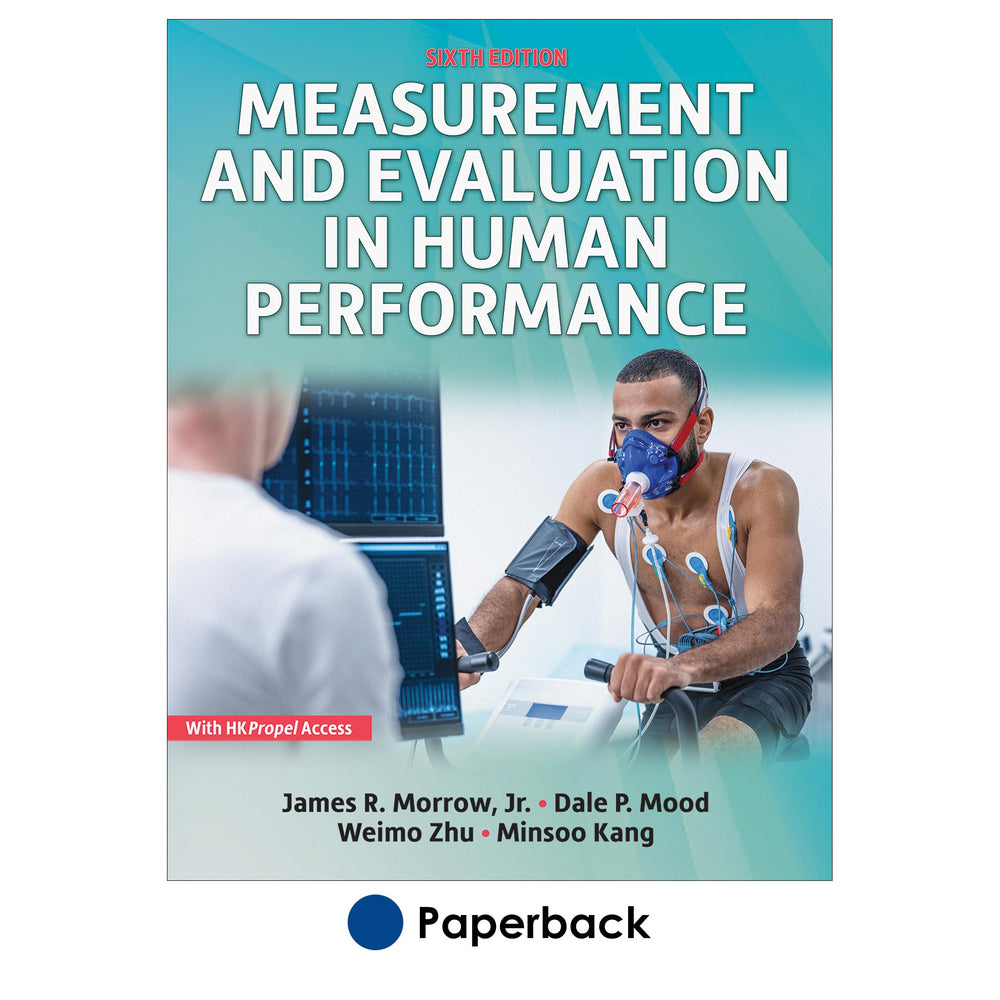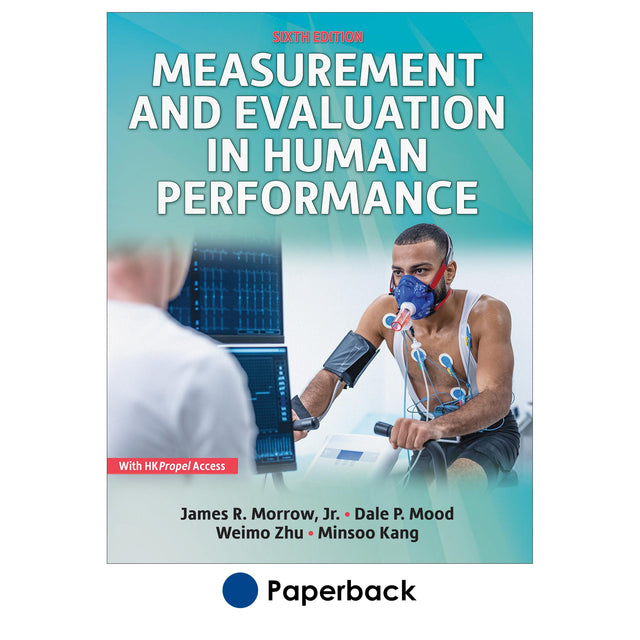Measurement and Evaluation in Human Performance 6th Edition With HKPropel Access
$129.00 USD
The sixth edition of Measurement and Evaluation in Human Performance has been reorganized to offer a logical progression of information that makes it easy for instructors and students to apply the content to their specific courses and career goals. It is enhanced with added expertise from new coauthor Weimo Zhu, an internationally known scholar in Kinesmetrics who served as the chair of the Measurement and Evaluation Council of SHAPE America. The amount of information on physical activity assessment has been increased across all chapters, and the text includes new content about sport video analysis apps, employment-related testing, and more.
The text is divided into four parts. Part I introduces the concepts of measurement and evaluation and their importance for decision making in human performance. Part II explains the use of statistics as core tools and resources for these evaluations and explains the various forms of statistical procedures often used in measurement. Part III presents reliability and validity from theoretical, comprehensive, and criterion-referenced perspectives. Skills gained through previous sections are applied to human performance issues such as evaluating a person’s aerobic capacity or muscular strength. Part IV applies all of the content from the previous sections to practical settings where students will use the knowledge gained in the text, covering topics like fitness assessment, performance assessment, motor behavior, and sport and exercise psychology.
To enhance student comprehension and retention, related online learning aids are delivered through HKPropel. Sample data sets allow students to practice data analysis, as do a wide range of study and practice activities. Chapter quizzes may be assigned to students by instructors and are automatically graded within HKPropel. In addition, Mastery Item sidebars throughout the text include problems and activities that test student knowledge, while Measurement and Evaluation Challenge sidebars provide scenarios that can be evaluated with the information from the chapter.
Measurement and Evaluation in Human Performance, Sixth Edition, continues to provide students with the tools and confidence they will need to gather reliable data, analyze it, and apply it in their work with clients.
Note: A code for accessing HKPropel is included with all new print books.
Audience
Undergraduate text for measurement and evaluation courses in exercise science, kinesiology, human performance, physical education, or health and fitness; also a reference for professionals in those fields.Chapter 1. Concepts in Tests and Measurements
Nature of Measurement and Evaluation
Purposes of Measurement, Testing, and Evaluation
Reliability and Validity
Domains of Human Performance
Summary
Chapter 2. Using Technology in Measurement and Evaluation
Principles and Practice of Using Technology in Assessment
Using Computers to Analyze Data
Using SPSS
Downloading Data Matrices
Summary
Part II. Basic Statistical Concepts
Chapter 3. Descriptive Statistics and the Normal Distributions
Scales of Measurement
Summation Notation
Reporting Data
Central Tendency
Distribution Shapes
Variability
Standard Scores
Normal-Curve Areas (z-table)
Summary
Chapter 4. Correlation and Prediction
Correlation Coefficient
Calculating r
Interpreting r
Prediction
Multiple Correlation or Multiple Regression
Summary
Chapter 5. Inferential Statistics
Hypothesis Testing
Independent and Dependent Variables
Overview of Hypotheses Testing and Inferential Statistics
Effect Size
Selected Statistical Tests
Summary
Part III. Reliability and Validity Theory
Chapter 6. Reliability and Validity
Reliability
Validity
Applied Reliability and Validity Measures
Estimating Agreement Between Measures Using the Bland–Altman Method
Summary
Chapter 7. Criterion-Referenced Tests: Cut Scores, Reliability, and Validity
Setting Criterion-Referenced Standards
Development of Criterion-Referenced Testing
Statistical Analysis of Criterion-Referenced Tests
Criterion-Referenced Testing Examples
Applying Criterion-Referenced Standards to Epidemiology
Summary
Part IV. Human Performance Applications
Chapter 8. Evaluation: Theory and Practice
Evaluations and Standards
Evaluation in School Settings
Process of Grading
Determining Instructional Objectives
Consistency in Grading
Grading Mechanics
Evaluation in Nonschool Settings
Summary
Chapter 9. Developing Written Tests and Surveys
Planning the Test
Constructing and Scoring the Test
Administering the Test
Analyzing the Test
Item Analysis
Sources of Written Tests
Questionnaires and Surveys
Summary
Chapter 10. Assessment of Health-Related Physical Fitness
A Brief History of Physical Fitness Testing
Health-Related Physical Fitness
Establishing the Risk for Fitness Testing and Exercise
Measuring Aerobic Capacity
Measuring Body Composition
Measuring Muscular Strength and Endurance
Measuring Flexibility
Health-Related Fitness Test Batteries
Fitness Test Batteries for Older Adults
Fitness Test Batteries for Children and Youth
Fitness Test Batteries for Special Populations
Summary
Chapter 11. Assessment of Performance-Related Fitness
Measuring Agility
Measuring Balance
Measuring Coordination
Measuring Power
Measuring Reaction Time
Measuring Speed
Measuring Other Performance-Related Fitness Components
Issues Related to Selection, Administration, and Use of Performance-Related Fitness Tests
Summary
Chapter 12. Assessment of Motor Abilities, Skills, and Performance
Testing Motor Abilities
Guidelines for Motor Ability, Skills, and Performance Tests
Effective Testing Procedures
Developing Motor Performance Tests
Issues in Skills Testing
Skills Test Classification
Purposes of Motor Performance Analysis
Sport Analytics
Video Analysis Apps
Employment-Related Performance Testing
Summary
Chapter 13. Assessment of Physical Activity and Energy Expenditure
A Chronological View of Physical Activity and Health Assessment
Physical Activity and Energy Expenditure
Methods of Assessing Physical Activity
Methods of Assessing Energy Expenditure
Selecting a Method of Measurement
Assessing Physical Activity in Children and Youth
Determining Dose of Physical Activity and Energy Expenditure for Health
Summary
Chapter 14. Psychological Measurements in Sport and Exercise
Sport Psychology: Performance Enhancement and Mental Health
Exercise Psychology: Psychological Benefits of Physical Activity
Trait Versus State Measures
General Versus Sport-Specific Measures
Quantitative Versus Qualitative Measurement
Cautions When Using Psychological Tests
New Technology for Assessment Practices
Tests Used in Sport and Exercise Psychology
Summary
Chapter 15. Performance-Based Assessment: Alternative Ways to Assess Student Learning
Impetus for Developing a New Type of Assessment
Types of Performance-Based Assessment
Establishing Criteria for Performance-Based Assessments
Subjectivity: A Criticism of Performance-Based Assessments
Selecting Appropriate Performance-Based Assessments
Issues to Consider When Developing Performance-Based Assessments
Improving Assessment Practices in Physical Education Settings
Summary
Appendix: Microsoft Excel Applications
Constructing and Scoring the Test
Issues Related to Selection, Administration and Usage of Performance-Related Fitness Tests
All ancillaries are free to adopting instructors through HKPropel.
Instructor guide. Includes sample course syllabuses, chapter review questions and answers, student activities and answers, homework problems and answers, and answers to all the Mastery Items and student activities found in the text.
Test package. Contains more than 900 multiple-choice questions. The files may be downloaded for integration with a learning management system or printed for uses as paper-based tests. Instructors may also create their own customized quizzes or tests from the test bank questions to assign to students directly through HKPropel. Multiple-choice questions are automatically graded, and instructors can review student scores in the platform.
Chapter quizzes. Contains ready-made quizzes (9-10 questions each) to assess student comprehension of the most important concepts in each chapter. Each quiz may be downloaded or assigned to students directly through HKPropel. The chapter assessments are automatically graded, and instructors can review student scores in the platform.
Presentation package. Features nearly 600 PowerPoint slides of text, artwork, and tables from the book that can be used for class discussion and presentation. The slides in the presentation package can be used directly within PowerPoint or printed to make handouts for students. Instructors can easily add, modify, and rearrange the order of the slides.
Image bank. Includes most of the figures, content photos, and tables from the text, sorted by chapter. These can be used in developing a customized presentation based on specific course requirements.
Videos. Dozens of brief videos summarize chapter content. Instructors can use the videos for review or preliminary preparation or as supplemental material during instruction. Students can use the videos for review, further clarification on a topic, and in preparation for chapter examinations.
Instructors also receive access to all student materials in HKPropel. For Measurement and Evaluation in Human Performance, Sixth Edition, this includes a wide range of study and practice activities as well as sample data sets for each chapter to allow students to practice data analysis. In addition, chapter quizzes (assessments) may also be assigned; these are automatically graded to test comprehension of critical concepts.





